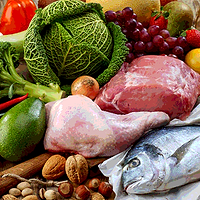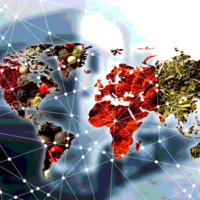The globe has never faced the extent of environmental change (EC) threats that we see today. EC can lead to extreme conditions such as high temperatures, catastrophic flooding incidents, heavy rainfall rate, rising sea-levels, ocean acidification and salinity, and droughts (for example, the global temperature is expected to increase by 1.8–4 °C in the coming decades and about 2–7 million more people will be affected by coastal flooding, per year, by 2080[1]), which can impact ecosystems and communities across the globe.
Even though the effect of EC on food safety is not fully understood, it could present a major health problem in both developed and developing countries. Recently, the incidence of foodborne infections has been significantly increasing. According to the U.S. Centers for Disease Control and Prevention, the incidences of most infections have increased in 2018 compared with 2015–2017. For example, in the U.S., the infections caused by Cyclospora, Vibrio, Yersinia, Shiga toxin-producing Escherichia coli, Campylobacter, and Salmonella have increased by 399 percent, 109 percent, 58 percent, 26 percent, 12 percent, and 9 percent, respectively, in 2018 compared with 2015–2017. Foodborne illnesses are making 600 million people ill and killing 420,000 people each year, mostly in developing countries. Unsafe food (resulting from EC) is expected to contribute to the 250,000 additional deaths per year between 2030 and 2050.[2]
Food can be contaminated with food safety hazards, at any stage of the food value chain, via direct contact with human/animal feces, infected food handlers, environmental contamination (e.g., food contact materials, air, water), or cross-contamination (contact with raw foods). Due to the globalization of the food supply chain (one in six people rely on imports to feed them in the globe today; for example, more than 50 percent and 15 percent of the total food consumed in the UK and the U.S., respectively, are not home grown), foodborne diseases do not respect cross-border boundaries; therefore, any EC that induces food safety changes in any country could have global consequences. EC could, directly or indirectly, impact food safety as follows:[3]
• Flooding can contaminate agricultural water, soil, and products with industrial waste and human sewage (sources for chemical and biological hazards). In 2002, very high levels of polychlorinated biphenyls (PCBs) were presented in soil and in milk following the Elbe and Mulde floodings in Central Europe. Floodwater was also found to be contaminated with oil spills and pesticides, following Hurricane Katrina in 2005. Flooding increases the existence of unsafe food (improper sanitation, storing and cooking due to the lack of facilities or fuel). Increase in both foodborne and waterborne diarrheal episodes have been reported in different developing countries including Bangladesh, Brazil, India, and Mozambique after severe flooding incidents.
• Rainfall can be contaminated with chemical hazards (e.g., fertilizers, heavy metals, and pesticides from soil and environment) and biological hazards (e.g., bacteria, viruses from sewage and animals feces) which can contaminate food. Run-off (resulted from rainfall) can carry nutrients (from fertilizer) into water bodies where algae (including those produce toxic compounds) can use to grow. Seafood (fish and shellfish) feed on these toxic algae where toxins (ciguatera fish poisoning, paralytic shellfish poisoning, etc.) can be concentrated inside seafood.
• Drought/dry season can also indirectly increase chemical hazards in agricultural products. For example, in Bangladesh, the levels of arsenic in soils increase during dry seasons because of using arsenic-rich groundwater (the main source of irrigation during dry seasons), which can contaminate crops.
• High temperature (e.g., during the summer) has always been associated with peaks of foodborne diseases:
° High temperatures support the survivability, growth, and the mode of transmission of bacterial, parasitic, and viral infections. For example, a) peaks of cholera are always associated with higher temperature in developing countries including African countries, Southeast Asia countries, and Haiti; b) an increase of 1 degree of temperature resulted in an 8 percent increase in diarrheal episodes in Peru; c) an increase in the number of cases of gastroenteritis with increasing temperature, over the coming century, in Australia is predicted; d) incidence of salmonellosis increased by 5.5 percent with a 1-°C increase in the mean monthly temperature in Kazakhstan; e) it has been predicted that the incidence of salmonellosis and campylobacteriosis will be increased by 2 percent and 3 percent, respectively, in Ireland, in the coming decades because of EC; f) it has also been predicted that there would be a doubling of the morbidity associated with salmonellosis due to EC in South Australia by the year 2050; and g) an extra 4,000–7,000 Salmonella cases, annually, is expected in Australia by 2050. On the other hand, viruses (e.g., norovirus) infections/outbreaks have been associated with colder seasons.
° High temperature and high moisture encourage fungal growth including those that form mycotoxins. It is predicted that aflatoxin contamination, and its associated food safety issues, will become prevalent in Europe with a temperature increase of 1 °C. An increase in the occurrence of Aspergillus flavus was associated with higher temperature in Italy and U.S.
° High temperature increases the susceptibility of animals to disease and leads to the spread of zoonotic diseases (e.g., mastitis caused by Staphylococcus aureus). Animal diseases may then result in an increased use of veterinary drugs (chemical hazard). High temperature is also associated with increased the use of antibiotics in aquaculture.
° High temperature promotes the growth of harmful algal blooms (HABs). HABs produce natural toxins (e.g., amnesic shellfish poisoning, azaspiracid shellfish poisoning, ciguatera fish poisoning, diarrheic shellfish poisoning, neurotoxic shellfish poisoning, paralytic shellfish poisoning) and consuming these contaminated seafood can result in human illnesses.
° Higher water temperature and salinity were also associated with higher levels of pathogenic Vibrio (V. paparahaemolyitic and V. vulnificus) in the environment and in oysters.
As has been mentioned above, EC will create more food safety challenges. Reversing EC is not an easy task; nevertheless, mitigating its impacts on food safety is a must. The following are approaches to enhance preparedness to overcome the adverse effects of EC on food safety/public health in developing countries:
• Developing countries must understand the negative effects of EC on food safety and must be prepared to address these effects.
• Develop stricter food safety regulations/standards and newer interventions (such as effective traceability systems, high quality data, whole-genome sequencing, etc.).
• All related sectors (health, agriculture, environment, nutrition, veterinary health services, etc.) should collaborate to prevent, detect, and manage the increased foodborne risks associated with EC.
• International food safety and public health organizations should work together to deal with food safety concerns associated with EC.
• International food safety organizations and donors should assist developing countries in enhancing their capacity building so they can develop effective food safety plans, including food safety emergency preparedness and response, which allow them to control foodborne risks associated with EC.
• Implement good food safety practices and integrated pest management programs.
• Establish effective inspection systems that allow affected foods to be properly inspected after EC incidents/natural disasters (e.g., flooding), so measures can be established to reduce the risk (e.g., pathogens, chemicals hazard) or to ensure the proper disposal of contaminated (unfit for human consumption) foods.
• Develop/implement effective food safety risk communication especially during natural disasters.
• Develop effective monitoring and surveillance programs (use of One Health system for humans, plants, and animals) where high-quality data can be collected to develop predictive modeling to rapidly respond to emerging food safety risks due to EC.
• Utilize international networks (e.g., INFOSAN) to develop/share effective monitoring and surveillance systems
• Utilize novel technologies (e.g., whole-genome sequencing, filtration devices, X-ray, vaccination of animals, etc.) to detect and control foodborne diseases.
• Use applied and cutting-edge research to solve real problems facing producers and food processors.
• Educate consumers on food safety hazards associated with EC.
Barakat Mahmoud, Ph.D., is an international food safety expert with 30 years of experience in food safety. He has provided technical assistance in food safety in several developing countries in Africa, Asia, Central America, the Middle East, and the Caribbean.
References
1. www.who.int/foodsafety/_Climate_Change.pdf
2. www.who.int/foodsafety/publications/all/Climate_Change_Document.pdf?ua=1.
3. .www.fao.org/3/i0195e/i0195e00.pdf.
Evidence-Based Approach to Overcoming the Adverse Effects of Environmental Change on Food Safety in Developing Countries




